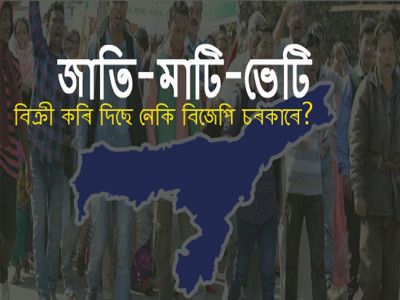
Eviction in Assam: Displacement, Demography, and the Deepening Divide
It’s been a long, hot summer in Assam. Not just in temperature, but in tension. Across districts like Goalpara, Dhubri, Lakhimpur, and Barpeta, bulldozers have arrived early and unannounced to some, but long-feared by many. What began as piecemeal evictions in patches of government and forest land has swelled into a sweeping campaign of displacement, touching the lives of more than 50,000 people in the past four years alone. And the state's justification, often repeated by Chief Minister Himanta Biswa Sarma, is as stark as it is controversial: to halt what he calls a “demographic invasion.”
In the quiet paddy fields of Lakhimpur, bulldozers arrived not as tools of development but as instruments of erasure. This is not the first such scene in Assam, and it likely won’t be the last. But the question that hangs over these actions is heavier than the dust they raise: Who truly belongs in Assam and at what cost?
A State’s Pursuit of ‘Order’
Since assuming power in 2021, Assam Chief Minister Himanta Biswa Sarma has made land reclamation a cornerstone of his governance narrative. Speaking openly of “demographic invasion,” Sarma insists these drives are necessary to protect the identity of indigenous Assamese communities. So far, over 1.19 lakh bighas of land, comprising forests, grazing pastures (VGR/PGR), religious land, and general government holdings, have been cleared.
The rhetoric is unambiguous. In public addresses, Sarma has linked the influx of settlers, often from Bengali-speaking Muslim communities, to a calculated demographic shift. “They go from constituency to constituency. After 20 years, they'll have 40,000-45,000 votes in each,” he warned recently, urging indigenous communities to resist what he terms a silent conquest.
A Human Cost Measured in Tents and Trauma
For many of those affected, however, the story is different. In villages like Phuhkhanhat and Baghjan, families have lived for decades, raising children and crops on lands that are now deemed “illegal.” Some came here after losing everything to river erosion elsewhere. Others say they have revenue receipts, voter cards, even Aadhaar, all markers of state recognition, but still found their homes reduced to rubble.
In Sonitpur and Darrang, clashes turned violent. In 2021, a 12-year-old boy was shot and killed during one such eviction. In Sonapur this year, two villagers were killed as police opened fire when protests turned chaotic. Local officials say they acted under orders. The victims' families say they were never given a chance.
There is little evidence of resettlement planning. Makeshift camps lack sanitation, healthcare, and education for displaced children. With monsoons approaching, even shelter becomes a question.
Procedure vs. Prejudice
What disturbs many observers is not merely the scale of these operations, but their legal ambiguity. In several cases, eviction notices were delivered less than a week before action. Few of the displaced were granted hearings. The Forest Rights Act, which protects tribals and forest dwellers from arbitrary displacement, remains underutilised.
Rights groups and legal scholars have raised alarms over procedural lapses. “Eviction without due process is unconstitutional, no matter who is targeted,” notes Guwahati-based legal expert Anuradha Deka. “We’re seeing mass displacements carried out with scant regard for documentation or appeals.”
More troubling still is the selective nature of these actions. Critics argue that the lens of enforcement disproportionately falls on Muslim-majority settlements, while others on similar land escape scrutiny. The CPI(M), Congress, and Jamiat Ulama-i-Hind have all accused the government of weaponising eviction as a tool of communal politics.
A Historic Pattern Resurfaces
Assam has long wrestled with identity and land. The 1980s saw the rise of the Assam Movement, demanding the detection and expulsion of "foreigners" a term that often blurred the line between Bangladeshi immigrants and Indian citizens of Bengali origin. The Nellie massacre of 1983, where over 2,000 Muslims were killed, remains a grim reminder of where unchecked suspicion can lead.
The National Register of Citizens (NRC) was meant to provide clarity, but it ended up sowing more confusion. Over 1.9 million residents were left off the final list in 2019. Today, with the NRC in limbo, eviction has become the latest stage in Assam’s long, uneasy reckoning with migration, land, and belonging.
The Silence of the Forest
The government asserts that many of these evictions are necessary for conservation, removing illegal settlements from elephant corridors or restoring forest land. But conservation without compassion is a hollow exercise. In the name of saving the forest, we risk destroying communities that have long coexisted with it.
Even the ecological rationale deserves scrutiny. Satellite imagery suggests that some reclaimed lands have quickly been turned over to agro-industrial use or security infrastructure. If the true intent is environmental, transparency is essential.
What Lies Ahead
For now, the bulldozers continue their work, leaving behind not just broken homes but a fractured public conscience. Assam’s landscape may change, but the deeper questions remain: Can development coexist with dignity? Can the law be enforced without bias? And can the state restore its forests without burning bridges with its people?
In a time of divisive narratives, Assam’s future may well depend not on how many acres are cleared, but on how many hearts are heard.
Disclaimer: The opinions expressed in this article are those of the author's. They do not purport to reflect the opinions or views of The Critical Script or its editor.

Newsletter!!!
Subscribe to our weekly Newsletter and stay tuned.

















Related Comments